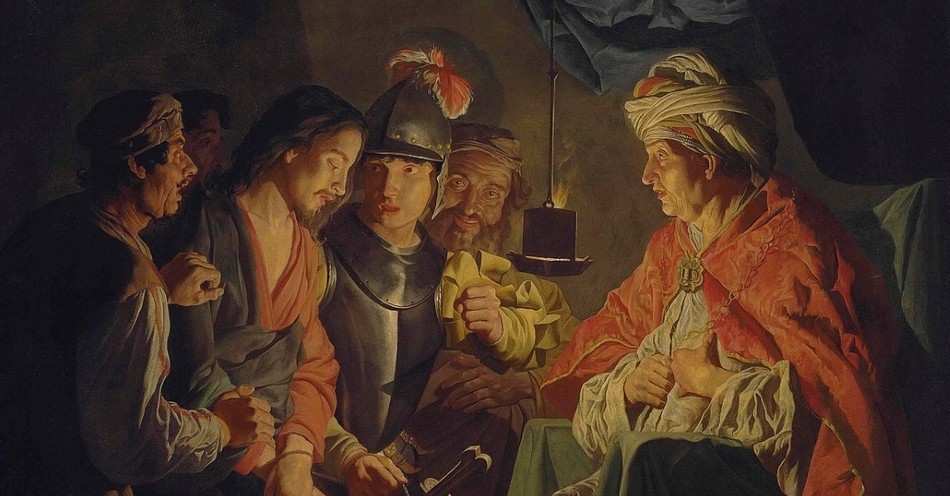Joseph ben Caiaphas, leader of the Sanhedrin, is only mentioned a handful of times in the Bible, but his impact was significant. He was the one who called for the crucifixion of Jesus following what he claimed was a prophecy he made: “that year that Jesus would die for the Jewish nation, and not only for that nation, but also for the scattered children of God, to bring them together and make them one. So from that day on they plotted to take his life” (John 11:51-53).
Ironically he was right, but not in the way that he thought.
Caiaphas meant it for his own glory, but God meant it for ultimate good and glory. Caiaphas’ only concern was that the Roman leaders he reported to would hear Jerusalem had trouble involving someone who claimed to be the Son of God. If he couldn’t control Jesus’ followers, who were growing in numbers, he would be out of a job or lose his life.
Who Was Caiaphas?
Caiaphas was a significant figure in the New Testament, serving as the high priest of Jerusalem from about AD 18 to 36. He is most well-known for his role in the trial and crucifixion of Jesus Christ. Caiaphas was one of the leading Jewish authorities who plotted to kill Jesus, viewing his teachings and claims of divinity as blasphemous and a threat to the religious and social order.
Caiaphas presided over the Sanhedrin, the Jewish ruling council, and played a crucial part in orchestrating the arrest of Jesus by "prophecying" Jesus' death and coordinating with Judas Iscariot.
Archaeological evidence, including the discovery of what is believed to be his ossuary, has provided some historical confirmation of Caiaphas' existence and his role as a high priest. His tenure coincided with a period of Roman rule in Judea, marked by social and political tension.
How Did He Become High Priest?
Caiaphas was a product of the divided Jewish Kingdom hundreds of years before.
When King Nebuchadnezzar of Babylon conquered Jerusalem and took the people to Babylon, he took them from the center of their life: Solomon’s Temple. Since they were exiled for 70 years, one of two things could have happened: either they held onto their Jewish faith and the Mosaic Law, or started living like the Babylonians around them. If you remember the story of Shadrach, Meshach and Abednego and how they were the only ones who didn’t bow to the statue of Nebuchadnezzar, does that give us a clue?
At the end of the 70 years, Cyrus, King of Persia, decided that the Jews could return to Jerusalem, but only to rebuild the temple. They were still living under Persian rule; they were not allowed to reestablish their nation. Yet other nations would know that this was the home of Yahweh’s people. But, according to The Jewish Virtual Library, few Israelites returned home, which made rebuilding the temple difficult.
With the rebuilding of the temple, they needed priests and high priests (from the line of Levi if they could find any who had returned). The priests returned to performing the priestly rituals and sacrifices that God had ordained for his people during the time of Moses. The sect of people who managed these duties was called the Sadducees. There was also a group called the Pharisees, political leaders who ensured Mosaic Law was followed.
After a time, the Greeks overthrew the Persians. Then the Romans overthrew the Greeks. Jerusalem fell to Roman power and became Rome's “client state” of Rome when General Pompey conquered Jerusalem in 63 BC.
Pax Romana, or “Roman Peace” was the law of the land. Britannica explains that the Pax Romana policy meant “The Roman empire protected and governed individual provinces, permitting each to make and administer its own laws while accepting Roman taxation and military control.”
By this point, High Priests were appointed by the Romans and expected to help keep the peace. This gave them elite status with the people and usually extra pocket change. As a high priest, Caiphas would have been a Sadducee, though some misidentify him as a Pharisee because the Pharisees appear more often in the Gospels.
Sadducees vs Pharisees
As mentioned earlier, the Sadducees became mostly the priestly class and were more influenced by the Greeks and Romans during their rule. Along with the temple, they could hold other positions of authority, like tax collection. The Pharisees were the political movement that made its business to maintain the purity of following Mosaic Law. This often meant imposing strict rules that kept people in bondage.
The two groups had three distinct differences of belief. The Pharisees cherished the oral tradition of the law (and later the written Talmud). They also believed in resurrection and the afterlife, which the Sadducees rejected. The Sadducees also didn’t believe in heaven or angels.
Bethany Verrett addressed their misgivings this way:
“Because both the Pharisees and the Sadducees lost sight of the purpose of their religion and the temple, to draw people closer to the one true God, they lost their own purpose. The Sadducees forgot about their own souls, the importance of their identity as children of Abraham, and why it was important for Israel to exist as a shining city on the hill for the nations.”
Why Did Caiaphas Decide to Kill Jesus?
Caiphas and his friends began plotting to kill Jesus shortly after a particularly incredible miracle.
Jesus had just brought Lazarus back to life, and the news spread like wildfire. “Many of the Jews who had come to visit Mary, and had seen what Jesus did put their faith in him” (John 11:43-45). Jesus had already been doing miracles and signs among the people—many healings.
Many more put their faith in him after seeing the resurrection of Lazarus. The word reached the Jewish leaders throughout much of Israel, especially Jerusalem. Finally, here was the Messiah they had been praying for their whole lives, who would save them from death and offer them eternal life. He literally showed them that He had the power of life over death.
But they wouldn’t have it. Jesus messed with the status quo because He didn’t say what they expected the Messiah to say or do what the Messiah was expected to do. It was time for Him to go.
What? Were they going to reject the one they had been waiting for? Yes, because in their greed and ignorance, they didn’t know what or who they were looking for, and they didn’t want to lose their positions of power.
Jesus made claims about ushering in a new kingdom, gave the common people hope of “blessedness” despite their problems, healed the sick, and encouraged people to help the poor. He also talked much about repentance which leads to a right relationship with God and eternal life. None of the things a Sadducee in power would agree with.
Since the time of Abraham, the Jews had known Yahweh, the one true God. To claim that God had a son would be blasphemous, and then to claim that as a human you were God’s son, would be beyond blasphemous. From Caiphas’ perspective, the statement also had personal stakes. For all he knew, Jesus’ remarks may have been all show to get authority over the High Priest and other authorities.
Caiaphas’ Trial of Jesus
The trial before Caiaphas was somewhat informal and appeared more as an interrogation aimed at finding evidence that could justify a death sentence under Roman law. The Gospels describe how false witnesses came forward but their testimonies did not agree. Finally, Caiaphas challenged Jesus directly, asking Him if He was the Christ, the Son of God.
The pivotal moment came when Jesus affirmed His identity, declaring that He was indeed the Son of God and that they would see Him sitting at the right hand of Power and coming on the clouds of heaven. This declaration led Caiaphas to tear his robes—an act of outrage and mourning over blasphemy—and declare that no further witnesses were needed.
Following Jesus' affirmation, the council deemed Jesus guilty of blasphemy, a capital crime under Jewish law, though they lacked the authority to execute the death penalty, which had to be sanctioned by Roman officials.
This interrogation and trial were not at all legal. First, the trial occurred at night when the Sanhedrin (who should have all been involved) was not in session.
Also, the preliminary questioning of Jesus before a full trial, or even conducting such a trial, was not in keeping with Jewish law. They also collected false witnesses and told them what to say (many of whom went on to incite crowds with chants of “Crucify Him!”)—also illegal.
Caiaphas' Death
The Book of Acts records Peter and John, post-resurrection, being called before the Sanhedrin to answer for claims that Jesus rose from the dead. Acts 4:6 states, “Annas the high priest was there, and so were Caiaphas, John, Alexander and others of the high priest’s family.” That is the last time in the Bible that Caiaphas is mentioned.
However, Josephus mentions that Caiaphas ruled until 36 AD, the same year he died.
Photo Credit: public domain painting via Wikimedia Commons.
Mary Oelerich-Meyer is a Chicago-area freelance writer and copy editor who prayed for years for a way to write about and for the Lord. She spent 20 years writing for area healthcare organizations, interviewing doctors and clinical professionals and writing more than 1,500 articles in addition to marketing collateral materials. Important work, but not what she felt called to do. She is grateful for any opportunity to share the Lord in her writing and editing, believing that life is too short to write about anything else. Previously she served as Marketing Communications Director for a large healthcare system. She holds a B.A. in International Business and Marketing from Cornell College (the original Cornell!) When not researching or writing, she loves to spend time with her writer daughter, granddaughter, rescue doggie and husband (not always in that order).
This article is part of our People of Christianity catalog that features the stories, meaning, and significance of well-known people from the Bible and history. Here are some of the most popular articles for knowing important figures in Christianity:
How Did the Apostle Paul Die?
Who are the Nicolaitans in Revelation?
Who Was Deborah in the Bible?
Who Was Moses in the Bible?
King Solomon's Story in the Bible
Who Was Lot's Wife in the Bible?
Who Was Jezebel in the Bible?
Who Was the Prodigal Son?




